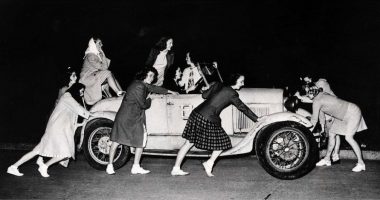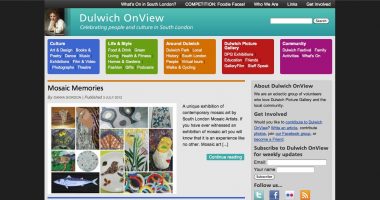
Portrait of Eliška Misáková at beam, 1935 | Wikimedia Commons | Public domain
These are overwhelming times. International conflicts, the climate crisis, fast-paced work environments and the aftermath of the pandemic are causing stress and anxiety around the world. More and more people are looking for ways to improve their mental health, and the wellness industry offers new experiences that promise healing and personal transformation. This trend encourages us to look inward, although along the way it often forgets the social and political facets of emotional wellbeing.
Mental health is no longer taboo. Elite athletes such as Naomi Osaka and Simone Biles are quitting competitive sports due to stress or anxiety; young artists are pouring their generational angst into anxiety pop and, as the effects of the climate crisis become more evident, we’re seeing a rise in what the American Psychological Association has termed eco-anxiety. This malaise is driving many people to seek solutions, often outside the conventional healthcare circuits, and helping to diversify the already buoyant personal wellness industry. In these times of confusion, the sector has strengthened its most introspective facet, reaffirming a new subjective turn that is worth analysing.
From experience to personal transformation
In 1998, a Harvard Business Review article heralded the emergence of the experience economy, describing how the market was shifting from a model focused on selling products and services to one based on experiences. Since then, this trend has benefitted from a world that has opened up. Thanks to the internet and low-cost travel, the leisure market has taken on a global scale, ushering in an understanding of status that focuses not just on the possession of objects, but on the enjoyment of experiences. Amplified by the emergence of social networks, this new culture of experience is measured not only according to what you have done, but also what you have shared on your digital profiles, with the related implications at the level of personal fiction and spectacle.
In a context of political, social and environmental upheaval, in which the most frivolous experiences clash with the current zeitgeist, the experience economy has found a new market niche oriented towards personal transformation, one that promises more significant moments on a personal and spiritual level. The concept of experience-as-medicine channels stillness, intimacy and introspection as new ways to achieve emotional balance; something that takes different forms.
The perambulations of mindfulness
Mindfulness has become so ubiquitous and ambiguous that it often refers to practices that are difficult to reconcile. Many people understand it as a self-awareness technique that draws on Buddhist meditation methods, but some companies also use it to label manicure sessions, sell shampoos or try to relax their staff (including such absurdities as the failed AmaZen booths in Amazon’s warehouses).
The teaching of meditation outside Buddhist monasteries has followed a complex historical process, initiated in Asia in response to the threat of Christian missionaries and colonisation. But leaving aside the details of this process, suffice it to say that the practice, especially in its calm-inducing forms, is nowadays an accessible and widely accepted activity in the West. In the United States alone, where the number of users of mindfulness apps has tripled in a decade, the sector is expected to exceed $2 billion by the end of 2022. This upward trend is attracting new companies and investors, who continue to launch apps in a market that numbers in the thousands.
This saturation of supply has led to expansion into new segments. On the one hand, there are the inevitable experiments in virtual reality and the metaverse, which, due to the very nature of these technologies, flirt with psychedelia. Apps like Tripp offer a “return to your true self” by combining mindfulness, visualisations and binaural audio. Wellness celebrity Deepak Chopra is developing his ChopraVerse, while yoga clothing brand Alo has already launched Alo Sanctuary, a space on Roblox where users can practice virtual yoga and meditation.
On a more prosaic level, the mindfulness market has also expanded, offering remedies for two contemporary ills: lack of sleep and lack of concentration. The most popular apps include sleep meditations, soothing soundscapes and storytelling, both for children and adults. There has also been a proliferation of focus music, which, with a clear link to productivity, helps listeners to concentrate during extended periods of study or work.
The causes that lead to stress, lack of sleep and concentration are very likely to be multifactorial, but it is not unreasonable to think that long working hours, the overuse of technology and the blurred boundary between personal and professional life may play an important role. As Jonathan Crary details in 24/7: Late Capitalism and the Ends of Sleep, throughout history, the market economy has tried to reduce the amount of time we spend slumbering, as it is one of the few moments from which it cannot extract productive value. It is therefore paradoxical that meditation apps, as well as the adoption of mindfulness in the global business culture, are presented as the solution to a problem that, to a certain degree, may be caused by these very spheres.
Minimalism and insecurity
In 2017, Netflix released Minimalism: A Documentary About the Important Things, introducing into popular culture a concept hitherto reserved for the fields of art, architecture and aesthetics in general. The film follows two American bloggers – now podcasters – who quit their jobs in telecommunications and marketing to proselytise for the idea of living with less. This message was later intensified by an even more powerful media figure: the Japanese Marie Kondo, who, with her tidying method, books translated into more than twenty languages and her own reality show – also on Netflix – promotes a lifestyle in which getting rid of unnecessary objects is presented as the ultimate path to happiness.
Minimalism seems an appropriate lifestyle for the times, now that it has become clear that a system based on accelerated consumption is not the greatest idea for the future of the planet. Faced with problems of unmanageable magnitude, more and more people want to change what is within their reach and to feel they can create an environment that is simple and aligned with their values, and to some extent under their control.
Cultural critic Kyle Chayka writes about all this in The Longing for Less, a book that traces the history and evolution of this phenomenon and laments its contemporary drift. For the author, minimalism fits perfectly with his situation and that of many people of his generation: millennials who have had to adapt to a system that demands work flexibility and continuous retraining, without the economic stability that would allow them to settle in one place. If the idea of happiness consists of having few possessions and no fixed abode, this philosophy makes a virtue of insecurity.
Even with sufficient financial resources, a full-throated defence of minimalism is ostentatious. As expressed ironically by the writer Chelsea Fagan in The Guardian, it is essentially an aesthetic choice that has been reframed as a moral one, presented as an alternative that transcends irresponsible consumerism and, tacitly, as an experience of personal transformation with an edge of spirituality.
Inequitable psychodelia
Whether as therapy or experience, the market for psychedelics is making a comeback. A new wave of research and companies are experimenting with legal treatments, some of them administered by medical professionals. Field Trip Health, a US company founded in 2019, runs five ketamine-assisted psychotherapy clinics, promising that the substance “can help us become who we were always meant to be”. It also offers a free app to guide people through their hallucinogenic journeys at home. Similarly, Nue Life, which offers therapy with the same substance via virtual sessions, has its own app to facilitate the process.
The promise of psychedelics is growing from different quarters and seems to fit well into corporate tech culture. However, this type of therapy is thorny for several reasons. On the one hand, it is only accessible to a privileged few, as it is not likely to be covered by the public health system in the short term. At present, and despite their efforts to offer remote experiences, a month’s ketamine treatment at Nue Life costs around $1,250, while an introductory treatment session at Field Trip Health costs $750, without taking into account the downtime involved. This is paradoxical in the United States, where the war on drugs has been a matter of state policy for half a century, and the consequences of which keep the prisons full of poor African Americans in the country’s major cities.
On the other hand, there is also a certain cultural tension. The use of psychedelics for introspection and healing is a technology that has been used by indigenous peoples for centuries, and the rise of such experiences is leading to a form of “hallucinogenic tourism” in countries such as Costa Rica, Jamaica and Mexico. Although some studies have qualified that this type of tourism generates benefits for local communities and, in fact, dignifies the figure of the indigenous person as sage, the mass exploitation of this type of travel without regulation or permits could obviously be harmful.
The politics of wellbeing
There is no doubt that exercising, eating well and learning to relax are activities that are beneficial for everyone, and our experience in recent years has shown that taking care of ourselves and others is an urgent and essential need. The same goes for introspection. Greater self-knowledge can help people to become more aware of their reality and try to improve it as much as possible.
The issue becomes tricky when these philosophies of wellbeing are privatised, resulting in forms of consumption which, moreover, tend to place the responsibility for personal happiness or unhappiness solely on individuals. Approaches of this kind are biased to say the least, as they ignore the influence of economic and social factors on our emotional state.
There has been proof of the relationship between social class and health since at least the 1980s, when an unprecedented UK study revealed that, although society as a whole was on the up, elements such as income, unemployment, housing, etc. affect a range of health indicators, from birth weight, to blood pressure, to risk of accidental death. Studies on gender and ethnicity point to similar, though less widely agreed upon findings, noting the negative effect of the still unequal distribution of household chores, as well as the disparate access to health care experienced by some ethnic groups at the institutional level.
The politics of wellbeing are also sometimes explicit. While some of the practices mentioned have their roots in the counterculture of the 1960s and 1970s, this is no guarantee that they are progressive today. Indeed, at a time when trust in traditional institutions is increasingly eroded, alternative ideas also attract reactionary and conspiratorial profiles, as shown by the proliferation of yoga teachers sympathetic to QAnon, the US pro-Trump conspiracy theory.
In short, practices conducive to peacefulness, calm, self-care and personal introspection should always be welcome, especially in a fast-paced society where it is difficult to stop and reflect. We simply need to realise that they are not enough on their own, and to consider how to address the challenges of mental health and wellbeing through discourse between individuals and society.





Leave a comment